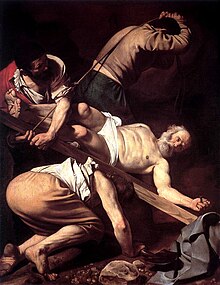|
Cross of Saint Peter
The Cross of Saint Peter, also known as the Petrine Cross, is an inverted Latin cross traditionally used as a Christian symbol, associated with the martyrdom of Saint Peter. In recent times, it has also been used as an anti-Christian and Satanic symbol. The symbol originates from the Catholic tradition that when sentenced to death, Peter requested that his cross be upside down. In Christianity  The origin of the symbol comes from the tradition that Saint Peter was crucified upside down.[1] This narrative first appears in the "Martyrdom of Peter", a text found in, but possibly predating, the Acts of Peter, an apocryphal work which was originally composed during the second half of the 2nd century.[2] In the Acts of Peter, the author writes that Peter's request to be crucified upside-down was to make a point: that the values of those crucifying him were upside-down, and that we need to look beyond the inverted values of this world and adopt the values of Jesus if we wish to enter the Kingdom of heaven.[3] Another common interpretation is that Saint Peter asked to be crucified upside-down because he felt that he was not worthy to die in the same way that Jesus was killed. Another important Christian who died in the same way was Philip the Apostle.[4] Non-Christian symbolThe cross of Saint Peter has also been used for non-Christian symbolism. A 19th-century occultist Eugène Vintras, known for his claim to be the reincarnation of the Prophet Elijah, was the first to wear the inverted cross.[citation needed] Vintras and his followers were condemned by followers of Pope Gregory XVI in an 1846 pamphlet, The Saints of Tilly-sur-Seulle, for homosexuality, conducting Black Masses in the nude, and masturbating on altars.[5] In popular cultureThe inverted cross is a recurring motif in metal music, particularly black metal, in congruity with its anti-Christian themes. One well-known example is Glen Benton of the band Deicide who branded an inverted cross onto his forehead.[6] Former Black Sabbath drummer Bill Ward suggested that the use of an inverted cross on the inner gatefold sleeve of their debut album by their label Vertigo may have been a promotional ploy or a misunderstanding of the nature of the group.[7] The Swedish metal band Ghost makes use of the inverted cross in place of the final "t" in the band's wordmark, as well as on singer Papa Emeritus I's chasuble. Also, Ghost uses an inverted cross bisecting the letter G as their logo, the Grucifix. Indie hip hop artist Tyler, the Creator draws the cross on his forehead for his 2011 album Goblin (deluxe). Experimental trap artist Playboi Carti utilizes the upside down cross for his 2020 album Whole Lotta Red. On the cover, Carti is depicted wearing an inverted crucifix pendant.[8] This piece of jewelry has remained a staple with his outfits. Similarly, his Opium signee Ken Carson has inserted the iconography into the cover for his 2023 album A Great Chaos.[9] Many horror films use inverted crosses as part of their imagery and marketing, especially if the film involves demonic themes. Examples include The Amityville Horror, The Conjuring and Paranormal Activity. At the end of Rosemary's Baby, an upside down cross hangs over the bassinet containing Satan's son. See alsoReferences
External links |

